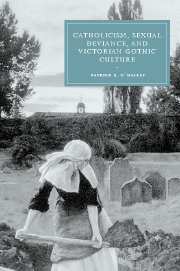Book contents
- Frontmatter
- Contents
- List of illustrations
- Acknowledgments
- Introduction: skeletons in the cloister
- 1 Goths and Romans: the literature of Gothic from Radcliffe to Ruskin
- 2 “The Church's closet”: Victorian Catholicism and the crisis of interpretation
- 3 Domestic Gothic: unveiling Lady Audley's Secret
- 4 The blood of the saints: vampirism from Polidori to Stoker
- 5 “Monstrous and terrible delight”: the aesthetic Gothic of Pater and Wilde
- 6 Conclusions: Oxford's ghosts and the end of the Gothic
- Notes
- Works cited
- Index
- CAMBRIDGE STUDIES IN NINETEENTH-CENTURY LITERATURE AND CULTURE
1 - Goths and Romans: the literature of Gothic from Radcliffe to Ruskin
Published online by Cambridge University Press: 06 July 2010
- Frontmatter
- Contents
- List of illustrations
- Acknowledgments
- Introduction: skeletons in the cloister
- 1 Goths and Romans: the literature of Gothic from Radcliffe to Ruskin
- 2 “The Church's closet”: Victorian Catholicism and the crisis of interpretation
- 3 Domestic Gothic: unveiling Lady Audley's Secret
- 4 The blood of the saints: vampirism from Polidori to Stoker
- 5 “Monstrous and terrible delight”: the aesthetic Gothic of Pater and Wilde
- 6 Conclusions: Oxford's ghosts and the end of the Gothic
- Notes
- Works cited
- Index
- CAMBRIDGE STUDIES IN NINETEENTH-CENTURY LITERATURE AND CULTURE
Summary
“Remember the country and the age in which we live. Remember that we are English, that we are Christians.”
Henry Tilney, in Northanger Abbey (1818)Catherine Morland's inauguration into rational adulthood, and indeed into the economy of marriage, depends, in Jane Austen's parodic vision of the last years of the eighteenth century, upon an understanding of the fundamental foreignness of the Gothic. Having mockingly instructed her in the use of language (“A faithful promise! – That puzzles me. – I have heard of a faithful performance. But a faithful promise – the fidelity of promising!” [171]), Henry Tilney now turns to instruct her taste and understanding of literature. The ostensible terms of Henry's dismissal of the Gothic are nation and religion; and in “the country and the age in which we live,” the fundamental dichotomy of religion is not so much the Christian and the non-Christian world but Protestant and Catholic Europe. “The visions of romance” having been dispelled, Catherine herself, still desirous of maintaining a Gothic presence somewhere, roughly traces this boundary:
Charming as were all Mrs. Radcliffe's works, and charming even as were the works of all her imitators, it was not in them perhaps that human nature, at least in the midland counties of England, was to be looked for. Of the Alps and Pyrenees, with their pine forests and their vices, they might give a faithful delineation; and Italy, Switzerland, and the South of France, might be as fruitful in horrors as they were there represented. Catherine dared not doubt beyond her own country, and even of that, if hard pressed, would have yielded the northern and western extremities. […]
- Type
- Chapter
- Information
- Publisher: Cambridge University PressPrint publication year: 2006



